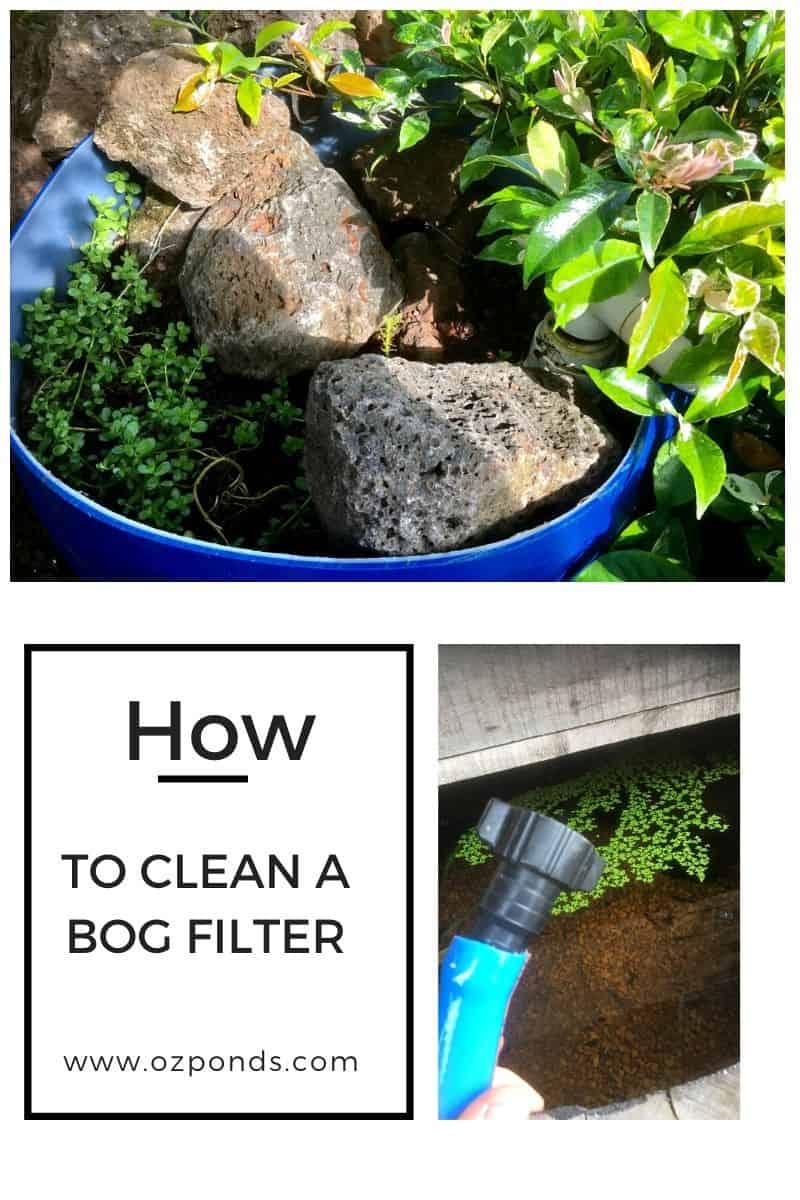A bog filter is the best biological filter for any pond!
They require very little maintenance. So when it’s time to clean them how do you do it?
4 Steps to cleaning a bog filter
- Give any overgrown plants a trim.
- Thin out any clumping plants that are becoming too big.
- Flush or pump out the accumulated solid material in the bottom of the bog.
- Top up the water lost during clean-out.
The importance of trimming the plants
The plants in the bog are incredible at removing excess nutrients from the pond.
Roots absorb the nitrate that is produced by the nitrogen cycle (link to article explaining the nitrogen cycle).
All the nutrients that they absorb they use to grow lush foliage and stunning flowers. This traps the nutrients.
But if the foliage is allowed to die and decompose within the bog filter all that trapped nutrient is released back into the pond.
Periodically trimming off dead and dying leaves and flowers will help the bog filter continue removing all those nutrients.
Why you should divide clumping bog plants
A well maintained and highly functioning bog filter will disperse water evenly through the gravel.
If clumping plants with thick roots are left unchecked they will form thick root mats.
These mats will trap sediments which is good. It prevents them going into the pond. But as the sediments build up the water finds other routes through the gravel.
Once the water is bypassing parts of the filter the efficiency begins to decrease.
This is because the area becomes anaerobic (starved of oxygen). Bacteria in anaerobic zones are much slower at breaking down the fish waste and other sediments.
The water moving up through the bog should move slowly but always be in motion. This allows aerobic bacterias (oxygen loving) to thrive.
Aerobic bacteria process waste at a much faster rate.
It’s a good idea to divide any clumping plants in the bog once a year. At least every second year.
I personally won’t use clumping plants in small bog filters. Shallow rooting plants are much easier to maintain and less likely to clog the bog.
In a large bog you still only need a few.
It is the bacteria and micro-organisms living in the gravel that provide 80-90% of the filtration.
How to flush out a bog filter
We this all depends on how the bog filter was designed.
One of the things I love about bog filters is that there are so many ways they can be created and implemented.
The most important thing is trapping and removing the build up of waste.
I get many messages asking for critiques on peoples bog filter designs.
Provided that these 3 things are achieved everything will be work.
- The size of the bog should be 10-25% of the pond. This is dependant on the size of fish being kept and how many. The average pond 10% should provide great filtration.
- Sediments like fish waste and decomposing organic material need to be trapped in the filter. To achieve this the water needs to move slowly through the filter.
- You need an easy way to remove the accumulated waste.
So here are some popular bog filter designs and how you flush them out:
| Style | How to flush |
| Nelson water garden bog filter | This type of bog filter has a network of dispersal pipes distributing water throughout a shallow bog. To clean high pressure water is forced through the dispersal pipes to flush out the solid waste. |
| Aquascape wetland style | This filter has a large pipe running through the bottom of the bog. Aquablox or milk crates are placed above the pipe to spread the water flow out evenly through the filter. A large vertical pipe is connected to the main pipe. This allows a sump pump to placed at the bottom of the filter to pump out the accumulated muck. |
| Container and Valve setup | This filter is constructed in a container. Water is pumped into the bottom and rises up through assorted rocks and gravel. A void is created at the base to allow solid waste to accumulate. A valve is connected to a discharge pipe at the bottom of the container. To Clean the valve is opened up and the solid waste flows out. |
| Aquaponic type bog filter | These filters use a stand pipe to set the water level of the bog. A gravel guard is positioned around the stand pipe to prevent it getting clogged. To flush the bog the stand pipe is removed. This completely empties the bog along with the sediments. Sometimes multiple flushes are required. |
All of these filters will do a great job. You can also utilise different parts from each design.
Here is a video of me cleaning out one of my wine barrel ponds. It is using an aquaponic style filter.
One of the important things that makes all theses filters so effective is that the water moves up through the bog. This is referred to as an up flow bog filter.
If you would like to learn more about designing effective and easy to clean bog filters you might like to check out the following articles I’ve written and of course subscribe to my YouTube channel.
Topping up the pond after a clean-out
Once the bog has been flushed out its important to get water back in there as fast as possible.
The whole success of the bog is based on the nitrifying bacteria living in there.
These bacteria need wet surfaces to survive.
So speed is important. It is also important that you don’t add untreated chlorinated water into the pond or bog.
Chlorine and chloramine are added to our tap water to kill bacteria and other pathogens that pose a threat to humans. They will also kill the good nitrifying bacteria in the filter and pond.
Treat the pond with a de-chlorinator such as prime (Amazon link) before topping up with tap water.
I also like to add bacteria after a clean-out, this will help replace any that were inadvertently discharged with the waste water.
Subscribe
Hopefully this article has been helpful.
I often receive special offers and discounts from pond suppliers and distributors. These special offers I share with my readers.
If you would like to receive these special offers and discounts make sure you subscribe to the mailing list, so I can deliver them direct to your inbox.

